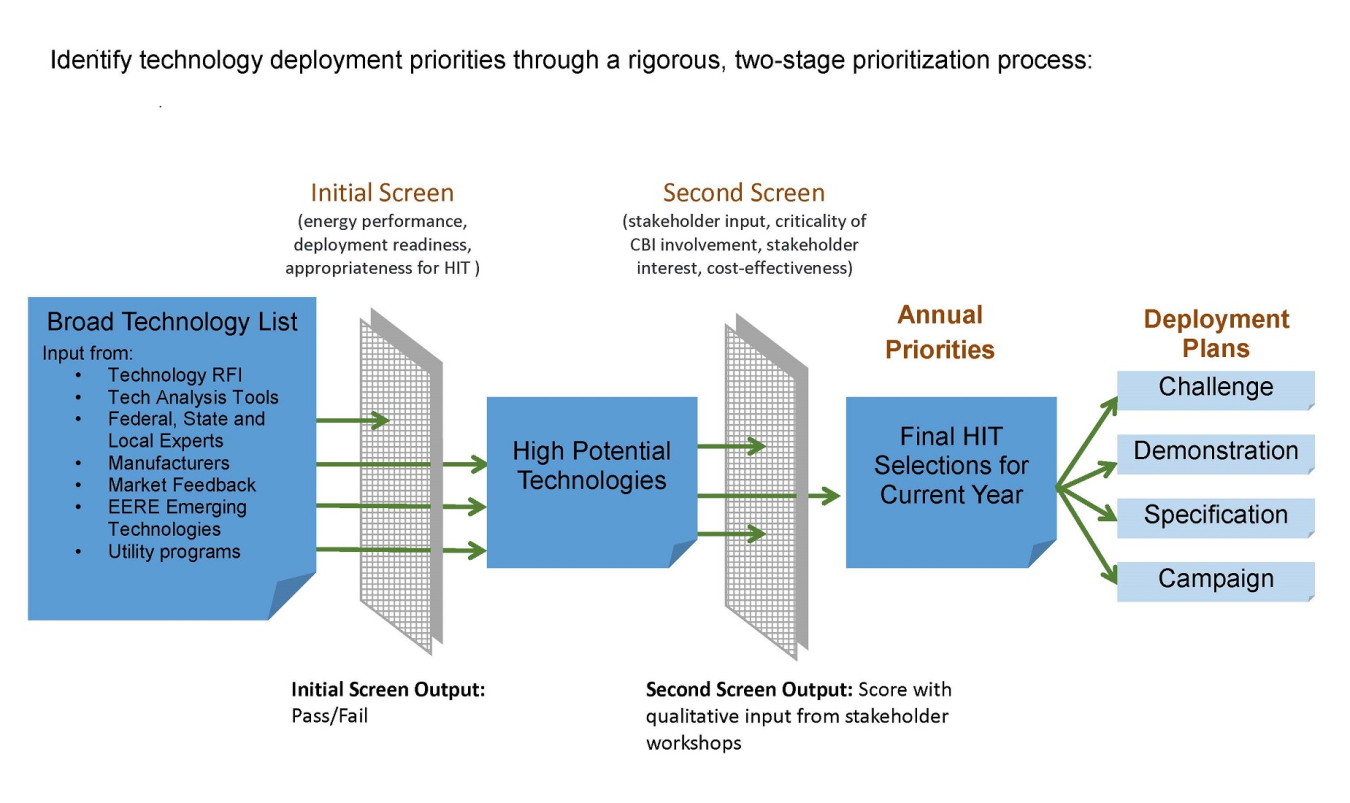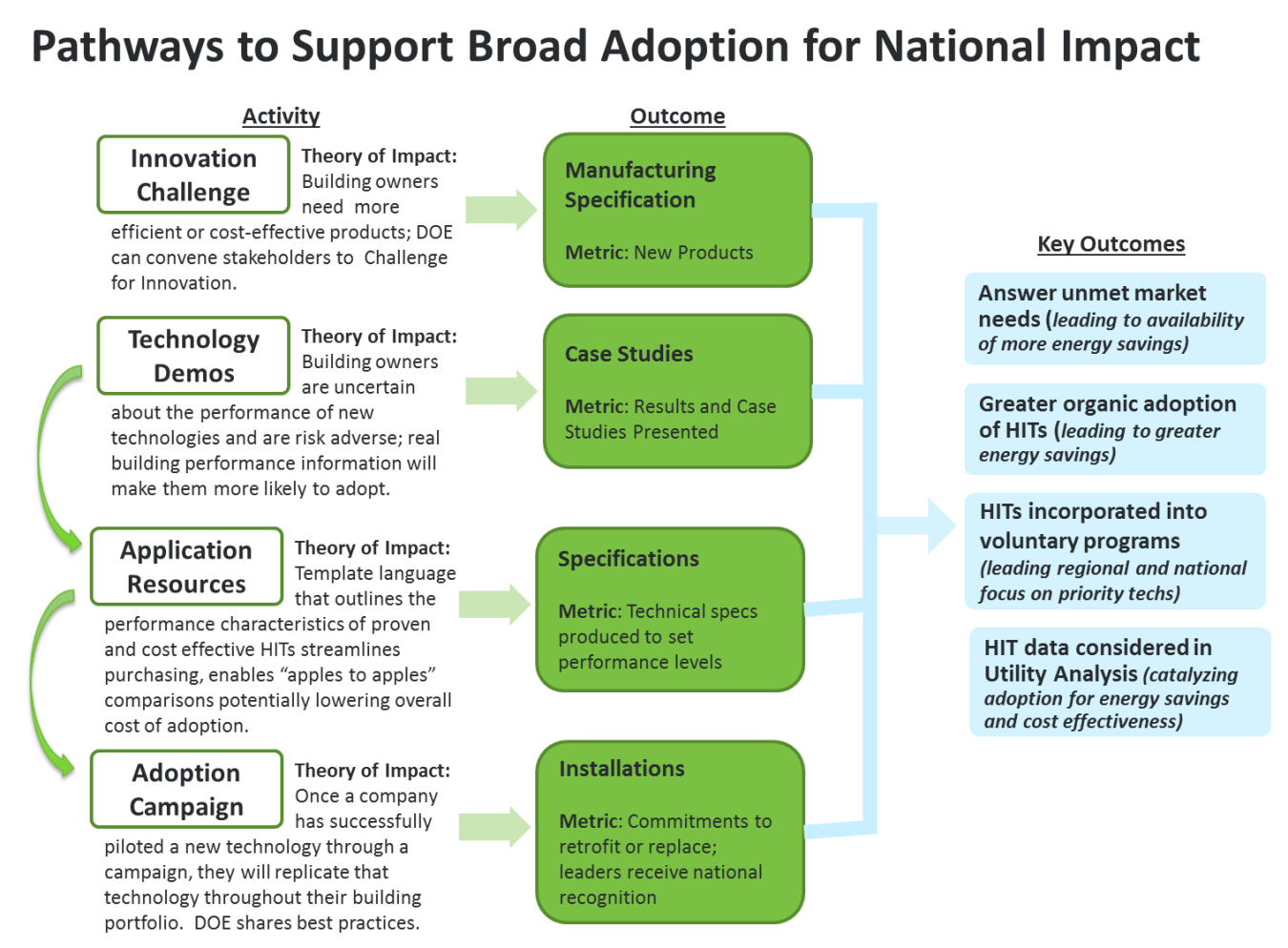
Demonstrating Efficient Solutions in Buildings (DES-B) is designed to help identify, prioritize and deploy cost-effective, innovative, energy-efficient technology solutions.
View the latest technology prioritization results.
View previous prioritization results.
Strategic Emphasis
We accelerate the adoption of innovative technology solutions through pre-identified and pre-defined pathways (e.g., Innovation Challenge, Technology Demonstration, Technical Resource development, Adoption Campaign) with an ongoing focus on partnerships and collaboration.
Target Market and Audience
We deploy DES-B projects with the commercial buildings industry including through the Better Buildings Alliance (BBA), federal leaders, regional nonprofits, and efficiency organizations.
Research, development and deployment strategies include technical and market analysis, the use of measure and stock-level analytical tools and laboratory and field testing to de-risk and streamline the adoption of technology solutions with significant energy savings and greenhouse gas reduction potential. This work leads to a better understanding of integration tradeoffs, structural and technical gaps, and long-term research and development requirements that will help CBI rapidly progress toward its goals.

Deployment Pathways
IoT-Upgradeable Lighting Challenge
Over 30% of lighting energy use can be saved with better lighting information and control. Connected and ubiquitous sensing on upgradable lights will provide the platform to optimize lighting systems and integrate with other building operational systems to promote better building performance. The IoT-DOE invites manufacturers to participate in the Upgradeable Lighting Challenge, to meet demonstrated market potential, by developing a luminaire that can be upgraded with IoT devices/sensors.
Low-Cost Wireless Submetering Challenge
The U.S. Department of Energy issued the Low-Cost Wireless Metering Challenge encouraging manufacturers to produce a cost-effective, accurate, wireless system capable of measuring various electric loads within a building and wirelessly communicating the data. A wireless submeter costing less than $100 and meeting all the specification was recognized by DOE. This submeter can be deployed by building owners and operators to gain greater insight and control over the $120 billion spent annual on electricity in commercial buildings.
Performance Specifications
- Advanced Power Strip Technical Specification
- Energy Management and Information Systems Specification and Procurement Support Materials
- Parking Lot Lighting Performance Specification
- Parking Structure Lighting Performance Specification
- Wall Pack Lighting Performance Specification
- Gas Heater Performance Specification
- Low Voltage Distribution Transformer Specification
- Ultra-low Temperature Freezer Specification
- Troffer Lighting Specification
- Commercial Heat Pump Water Heater
Installations and Operation Guides
- Exterior Lighting Controls
- Plug and Process Loads Capacity and Power Requirements Analysis
- Energy Management Systems for Food Service Applications
- Refrigeration Commissioning Guide (ASHRAE)
- Guide for Retrofitting Open Display Cases with Doors
- Fume Hood Sash Management
- Getting Below Six Air Changes in Laboratories
- Operating an Ultra Low Temperature Freezer
- Minimizing Simultaneous Heating and Cooling in Laboratories with Reheat Systems
- Solar Decision Guides for Healthcare, Hospitality and Leased Buildings
The Next Frontier: Lighting as a Connector for Building Systems
Today’s leading-edge lighting systems are capable of communicating with other building systems to enable additional energy-saving opportunities while collecting valuable insights about a business’s operations. However, less than 1% of systems are currently connected. The Integrated Lighting Campaign is a public-private partnership program to catalyze adoption, provide technical assistance and recognition for best practices and to track metrics associated with integrated lighting system costs, benefits and applications.
Pushing the Envelope: Windows, Walls, Roofs
The building envelope (windows, walls, roofs) accounts for approximately 30% (or 4 Quadrillion Btu) of the primary energy consumed in commercial buildings. Envelope systems are critical to the delivery of comfortable, productive, safe and health conditions in the building. The Building Envelope Campaign helps building owners and managers create more energy-efficient buildings by improving the performance of building envelopes in both new and existing buildings. This is achieved by setting goals for building envelope performance, determining available energy savings, and providing technical support and recognition to building owners and managers.
Making Small and Medium Commercial Buildings Smarter through Improved HVAC Controls
Most commercial buildings in the United States are either small or medium sized buildings served by packaged rooftop HVAC units (RTUs). Yet only 13% of these buildings incorporate HVAC controls. To help increase adoption and lower market barriers, Smarter Small Buildings Campaign offers technical assistance and recognition opportunities for improved HVAC controls, which can save 10-20% in energy costs for small and medium sized buildings. The Campaign works directly with building owners and managers to help reduce energy costs, improve occupant comfort, and meet sustainability goals. It also partners with technology vendors/manufacturers, HVAC contractors, utilities, and other organizations to help lower market barriers to improved building performance.

